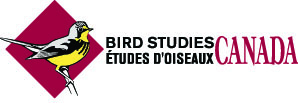Blue Jays and Stellar’s Jays
 Guest blog contribution from Steven Price, President, Birds Studies Canada.
Guest blog contribution from Steven Price, President, Birds Studies Canada.
Blue Jay
East of the Rockies, Blue Jays are familiar to most gardeners, cottagers, and backyard bird enthusiasts. (And major league baseball fans, too!) Jays store food for future use, so you may see them filling up frequently at bird feeders.

Photo Credit: Ron Ridout
When cleaning my eavestroughs each fall, I usually find several unshelled peanuts! A squawky jay-jay call boldly announces their arrival, but listen too for a rusty-hinge squeak. More than once I’ve heard the loud keyeer shriek of a Red-tailed Hawk, only to look up and see a Blue Jay, perhaps mimicking the hawk to clear the feeder of other birds before gorging. Larger seeds and peanuts will attract Blue Jays, as will an oak tree laden with acorns.
In fact, their fondness for burying acorns is thought to have helped oaks spread after glaciation – a bright blue reminder that species are key parts of larger ecosystems supporting all life on Earth.
______________________________________________________________
Steller’s Jay
Steller’s Jays are found in British Columbia and occasionally Alberta, from the Canadian Rockies westward. I’ve often noticed them high up in trees or been surprised by them swooping by.

Photo Credit: May Haga
These jays are at home in mountain evergreen forests, but frequently visit backyards, farms, parks, and campgrounds. Be alert – they can be swift, silent thieves of unattended picnics! Like many jays and their cousins the crows and ravens, Steller’s Jays expertly imitate the sounds of other birds, and even cats and dogs. They eat what’s available, including a wide range of wild fruits, seeds, nuts, insects, and most offerings at bird feeders.
They’ll happily raid your feeder of considerable bounty, hiding it around the landscape and showing a pretty impressive memory of where they’ve cached food. Other bird and mammal scavengers also benefit from this food disperser. The beautiful and intelligent Steller’s Jay is the provincial bird of British Columbia – in my view, a great winged choice to represent the province.
Steven Price
President
Bird Studies Canada



